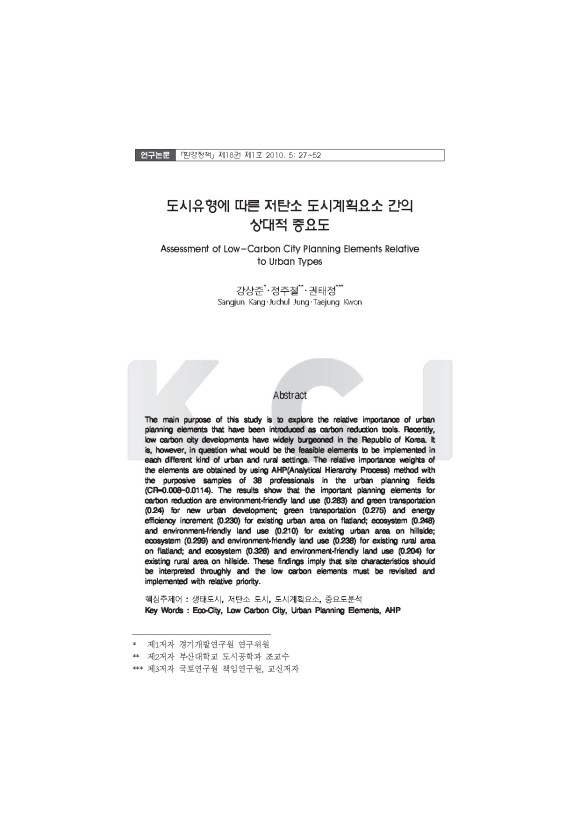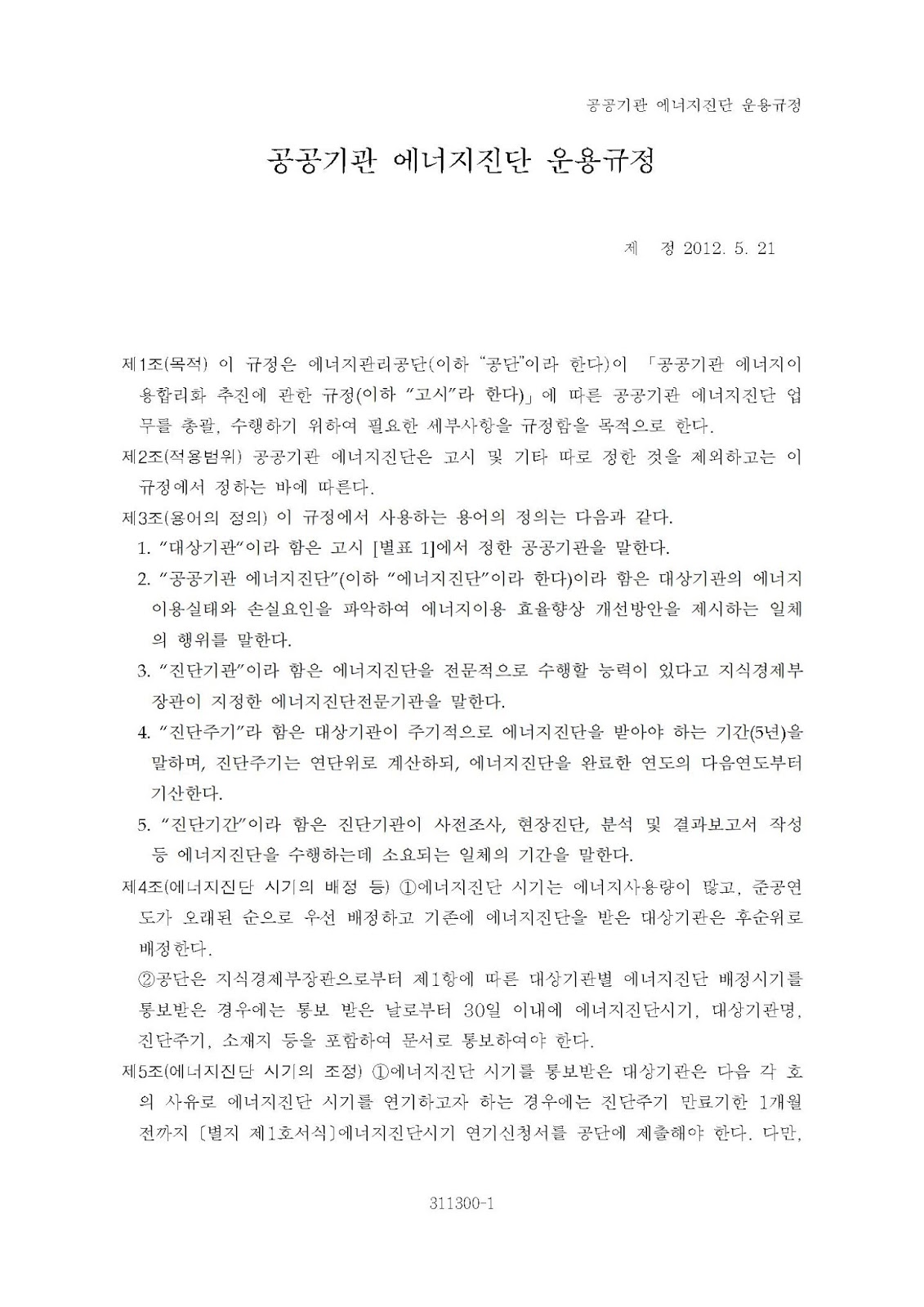도시유형에 따른 저탄소 도시계획요소 간의 상대적 중요도
도시유형에 따른 저탄소 도시계획요소 간의 상대적 중요도
Assessment of Low-Carbon City Planning Elements Relative to Urban Types
저자 강상준, 정주철, 권태정
소속 경기개발연구원, 부산대학교, 국토연구원
학술지정보 환경정책 KCI
발행정보 한국환경정책학회 2010년
자료제공처 국회도서관 한국학술정보 NRF
주제분야 사회과학 > 정책학 , 공학 > 환경공학
<초록>
The main purpose of this study is to explore the relative importance of urban planning elements that have been introduced as carbon reduction tools. Recently, low carbon city developments have widely burgeoned in the Republic of Korea. It is, however, in question what would be the feasible elements to be implemented in each different kind of urban and rural settings. The relative importance weights of the elements are obtained by using AHP(Analytical Hierarchy Process) method with the purposive samples of 38 professionals in the urban planning fields (CR=0.008~0.0114). The results show that the important planning elements for carbon reduction are environment-friendly land use (0.283) and green transportation (0.24) for new urban development; green transportation (0.275) and energy efficiency increment (0.230) for existing urban area on flatland; ecosystem (0.248) and environment-friendly land use (0.210) for existing urban area on hillside; ecosystem (0.299) and environment-friendly land use (0.238) for existing rural area on flatland; and ecosystem (0.326) and environment-friendly land use (0.204) for existing rural area on hillside. These findings imply that site characteristics should be interpreted throughly and the low carbon elements must be revisited and implemented with relative priority.
The main purpose of this study is to explore the relative importance of urban planning elements that have been introduced as carbon reduction tools. Recently, low carbon city developments have widely burgeoned in the Republic of Korea. It is, however, in question what would be the feasible elements to be implemented in each different kind of urban and rural settings. The relative importance weights of the elements are obtained by using AHP(Analytical Hierarchy Process) method with the purposive samples of 38 professionals in the urban planning fields (CR=0.008~0.0114). The results show that the important planning elements for carbon reduction are environment-friendly land use (0.283) and green transportation (0.24) for new urban development; green transportation (0.275) and energy efficiency increment (0.230) for existing urban area on flatland; ecosystem (0.248) and environment-friendly land use (0.210) for existing urban area on hillside; ecosystem (0.299) and environment-friendly land use (0.238) for existing rural area on flatland; and ecosystem (0.326) and environment-friendly land use (0.204) for existing rural area on hillside. These findings imply that site characteristics should be interpreted throughly and the low carbon elements must be revisited and implemented with relative priority.
<목차>
도시유형에 따른 저탄소 도시계획요소 간의 상대적 중요도 / 강상준 ; 정주철 ; 권태정 1
[요약] 1
I. 서론 2
II. 저탄소 도시의 배경 3
1. 포스트모더니즘 시대 도시계획사조 4
2. 생태도시 6
3. 저탄소 도시 7
III. 저탄소 도시 조성을 위한 계획요소 9
IV. 저탄소 도시계획요소 간 중요도 분석 12
1. 적용대상 유형 설정 13
2. 전문가를 대상으로 한 계층화분석(AHP) 16
3. 분석 결과 18
V. 결론 및 시사점 21
|참고문헌| 24
[저자소개] 26
 저희 (주)한국녹색인증원은 '지속가능한 저탄소 녹색건축인증 기술연구소'의 전문기업으로 설립되어, 빠른 제도 변화와 변모하는 건설환경에 이바지하고자 합니다. (주))한국녹색인증원은 건축, 도시, 생태분야가 녹색건축물에 접목될 수 있도록 적절한 요소분석을 통해 에너지 절감형 건축, 자생적 생태환경, 온열환경, 빛환경의 면밀한 조사와 연구로 고객의 삶의 질 향상 및 더 나아가 인류의 존속성에 그 목적을 두고 있습니다. 한국녹색인증원은 친환경컨설팅 전문업체로 주택성능등급, 그린홈, 에너지소비총량제, 에너지성능지표검토서, 건물에너지효율등급, 장수명주택
저희 (주)한국녹색인증원은 '지속가능한 저탄소 녹색건축인증 기술연구소'의 전문기업으로 설립되어, 빠른 제도 변화와 변모하는 건설환경에 이바지하고자 합니다. (주))한국녹색인증원은 건축, 도시, 생태분야가 녹색건축물에 접목될 수 있도록 적절한 요소분석을 통해 에너지 절감형 건축, 자생적 생태환경, 온열환경, 빛환경의 면밀한 조사와 연구로 고객의 삶의 질 향상 및 더 나아가 인류의 존속성에 그 목적을 두고 있습니다. 한국녹색인증원은 친환경컨설팅 전문업체로 주택성능등급, 그린홈, 에너지소비총량제, 에너지성능지표검토서, 건물에너지효율등급, 장수명주택






(%EC%A0%9C19819%ED%98%B8)(20250501)001.jpg)
(%EC%A0%9C34657%ED%98%B8)(20240710)001.jpg)
댓글
댓글 쓰기